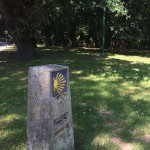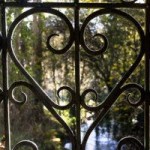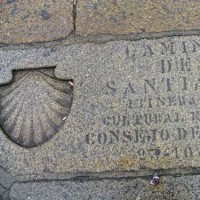
Obradoiro Square
How better to start our route that since the emblematic Plaza del Obradoiro, meeting place for pilgrims, the Km 0 of the Way of Sant James, and start point for the Way of Fisterra, from where we will continue the route I Caminos. This square is a true depiction of the 4 powers of the city: the church represented in the Cathedral , the knowledge due to to the University rectory, the politic power represented by the Palacio de Raxoi and headquarters of the city council, and presidence of the Xunta de Galicia and his Tourism, represented by the jewel of Paradores Nacionales with the Catolic Kings Hostel.
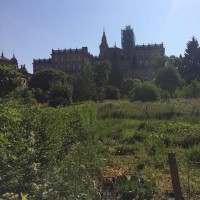
Way of Fisterra: since Obradoiro Square , by the Road Das Hortas to Carmen de Abaixo
We get out of Obradoiro Square by Costa do Cristo to the road Das Hortas, traversing the road Carretas, wich has that name because of it was the way where carts get out of the city with the deads of the pilgrims hospital ( actually the Catolic Kings Hostel) in direction to the cemetery. Just in the entrance of the road Das Hortas, we find the church of San Fructuoso, in the middle, one alley called Ruela de San Clemente, wich we recomend to see nice sights of the Cathedral. The arriving at Carmen de Abaixo, it's made a stop to see a little river and a little chapel, to see if we still in Santiago.
Oak groves and Pazo de San Lorenzo. Way of Fisterra.
Following a little trail near to the AC Hotel, crossing some little gardens, we will arrive to the Oak groves and Pazo de San Lorenzo of Trasouto, ordered to be built on the XIII secule. The Oak groves are carateristic and legendaries in Galicia, normally with a water fountain in mid and near to zones with a church and houses as in this case. We recomend to visit the "pazo" to see the church and the altarpiece of Carra made of marmol and the misterious labyrinth on the cloister.
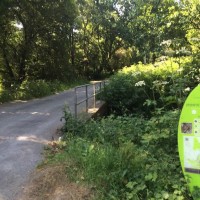
Transition of the Way of Fisterra to the Portuguese Way : Ponte Sarela, and Neighborhood of Vidán.
Going along the wall of the state of the Pazo de San Lourendo, descending by the road Dos Canos, we arrive to Ponte Sarela, where we apreciate a curious urbanization of Victor Lopez Cotelo, integrated in the nature and one industrial enviroment of and old fabric of leatherworks, very important in the santiaguese enconomy in previous secules. If we follow the road of the Way of Fisterra, in the climb we will see a nice panoramic of the Cathedral of Santiado, proposing a descending to the neighborhood of Vidán .
Following the curse of our route, we continue bordering the wall of the state of San Lorenzo, still getting in in a curious zone where the river stills present by one wood trail to finally end in the road of Noia. Then the nature will company us to the neighborhood of Vidan. We will see a water fountain with 2 decapitated heads and one rustic laundry, continuing the road we will arrive to the Portuguese way
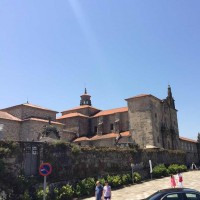
The Portuguese Way to the neighborhood of Conxo
We've been in Vidán neighborhood leaving the Lavadoiro da Ponte Vella and entroncamos directly with the Portuguese Way. Meet pilgrims who come for the Portuguese Way and an interesting private museum of the Forge to get into a path full of thick vegetation that leads to one of the most beloved neighborhoods of the city, the neighborhood council Conxo which was independent until 1925 .
We pass by a peripheral rural area to the city, to single-family houses where neighborhood life is felt in every corner, to reach the Campo de Conxo, where there is an old monastery with a beautiful church, the church of Santa Mary and the former Mercy convent, now headquarters of the first psychiatric hospital in Galicia.
Very close to this environment and find with the environment Stone monastery, we have Aurelio Aguirre contemporary cultural center designed by the architect Alfonso Penela and Novas Center of Galicia Tecnoloxías Architect Francisco José Mangado, an exponent of the new architecture in the neighborhoods from the city.
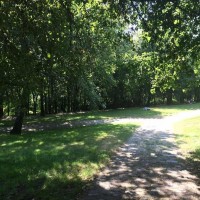
The neighborhood of Conxo to the Paxonal , neighborhood of Sar and route de la Plata
Taking a small path with flowered houses near Ponte Pereda, we go through a tunnel that will put us on the periphery of Eugenio Granell Park , the old garden do Paxonal , where a large green space bordered by a river leads to a beautiful carballeira where the city coexists peacefully with him.
Following the natural walk, we move towards Brañas ( meadows) do Sar to enter through the back of the bridge and so famous Colegiata de Sar , one of the oldest in town ( XII century) where we start to find us with pilgrims running down the path of route of silver.
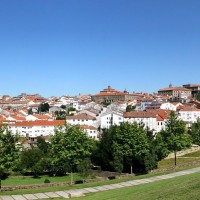
To the French Way : Belvis Park to Rua de San Pedro
Ascending the neighborhood of Sar to Santiago , we turn to the Belvis Park , this large green space, with a beautiful and curious labyrinth bush of Camelias , which leads us between terraces at the top to the viewpoint of Belvis , where we can see a curious view of the Old Town and that puts behind our backs Minor Seminary , the Convent of Belvis and an original contemporary architecture of John Hejduk ( USA ) , master of masters of modern architecture , represented by the byline cultural center Trisca , where the glazier had to make efforts to fit them between small skylights and balconies of a building special byline . We continue along the street towards a trisca Rúa San Pedro , in the French Way

French Way: A Rúa de San Pedro and the environment Bonaval
We are in the heart of the French Way at his entrance to the historic center of Santiago. Constant Pilgrims crossing leads to A Porta do Camino, turning off some of the strangest places in the city: The environment of Bonaval Park, the Museum of the Galician People and the CGAC: the Galician Center for Contemporary Art.
We propose to devote time to this location, first by contrasting architectures. Second by the beautiful Church of Bonaval, which has the Pantheon of Illustrious Gallegos but it is nonetheless of a space and respect for the great writers and illustrious Galicians who rely on it: Rosalia, Castelao, Otero Pedrayo ...
Get into Bonaval Park is to enter a magical space. A statue of Chillida that frames the old town, the water flowing throughout the park, statues, nobody will be surprised if they see children playing among former Bonaval cemetery niches. A place that offers tranquility, induces reading and has a good view of the city from its highest point. Cross the door highest point of the park to follow the trail that takes you to park of Almáciga.
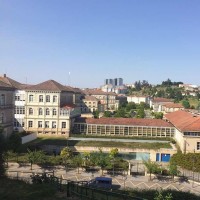
To the English Way around Almáciga .
While still looking back admiring the views offered from the historic center Bonaval , we came face to face with an overview of the City of Culture rather curious and the Pico Sacro background if the day is clear , entering the Almáciga park , the highest hill in the village with good views of the city .
We not intend to continue the route without regard to the views offered of the Xunta, Fontiñas and As Cancelas , which is less spectacular than the natural view to the old town but it gives a panoramic view of the city from this vantage unpublished quite well.
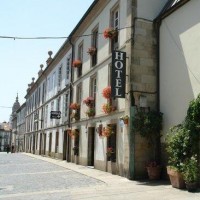
English Way to Km 0 of the Camino
We are in the neighborhood of Almáciga, another typical neighborhood where small houses still in some parts of the road versus the past of time and modernity. We are in direction to the road of Loureiros where we can see in the left the big baroque façade of the convent Santa Clara (original from s. XIII) and the convent El Carmen at right, getting close to the Old Town.
There is one stop we must to to see the views of the convent San Francisco since the top of Costa Vecha or to rest placidly in the terrace- garden of the Hotel. Continuing straight we find the church of San Martín Pinario, a hidden treasure of Santiago’s heritage where it is very recommended the entrance to see the impressive baldachin.
The road starts narrowing in direction to the road of As campanas de San Xoán, a typical alley in Santiago that borders the Monastery of San Martín Pinario and then A Inmaculada Square, situating us on a side of the Cathedral of Santiago called before as Paradise’s Door because of his beauty. The San Martín Pinario façade, the Palacio de Xelmirez to reach the km 0 of the Camino in the majestic door of the Obradoiro Square.


